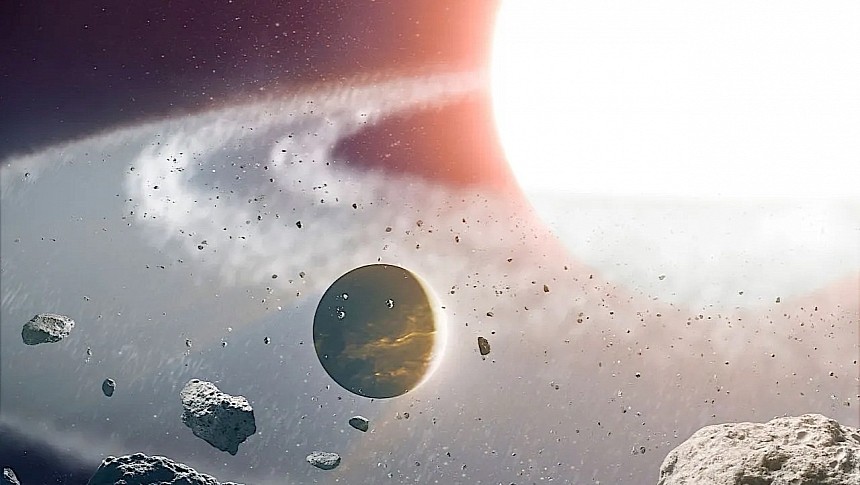Take a close look at the Sun that fuels the life on our planet. A source of light and warmth for all Earth-dwelling creatures, it is moving, like all other things in our universe, towards its inescapable demise. In five billion years, it will turn into a red giant, destroying most of the solar system in the process.
As it stands today, the Sun has a diameter of about 870,000 miles (1.4 million km). In the far future, as it burns through its hydrogen reserves, it will begin to swel, growing to much larger dimensions: anywhere between 62 and 620 million miles (100 million to almost one billion kilometers) in diameter.
Those may seem like simple numbers on the screen, but they meant the end of our civilization as we know it. The growth of our Sun is well within striking range of Mercury, Venus, Earth, and Mars, meaning all of the solar system's rocky planets. What that means is they all be obliterated, and there's not a single thing we can do about it.
Suns turning red giants is something that commonly happens in the solar system, and probably there are planets and civilizations being destroyed on a regular basis. The same fate should have been reserved for 8 Ursae Minoris b, a planet located 530 light-years from Earth, in close proximity to its star, currently a red giant.
The planet was spotted for the first time back in 2015, but today's astronomers have pointed the Transiting Exoplanet Survey Satellite (TESS) at it for a closer look. And found it's a giant exoplanet whose existence has humans scratching their heads.
You see, 8 Ursae Minoris b is presently (and by presently I mean as it was when it emitted the light that just reached us) located 0.5 astronomical units from its star. At its time of greatest turmoil, the local Sun would have expanded to 0.7 astronomical units, thus well past the planet itself.
And that can mean one of three things. The first is the planet gave death at the hands of its sun the finger, and through some process we don't know about managed to survive the star's expansion, or was spared in some sense. In all fairness, this is the least likely theory, as nothing can really survive a star's expansion.
The second theory is that maybe the planet is a survivor of two stars merging. This is a complicated scenario, as it involves two stars orbiting each other, and the planet itself. In time, the suns could have evolved at different rates, with one of them turning red giant and then white dwarf before the other.
The star currently visible from Earth could be the remnants of a collision between the two suns, which could have occurred just as the second one was about to reach the red giant stage. That would have stopped it from expanding, thus saving the planet.
The last possibility is that the planet was formed after the two suns collided, coalescing from the remnants of the violent transformation.
A detailed look at the planet, its star, and the possible ways it could have survived a red giant can be had in a paper published by astronomer Marc Hon of the University of Hawaii in Nature.
Those may seem like simple numbers on the screen, but they meant the end of our civilization as we know it. The growth of our Sun is well within striking range of Mercury, Venus, Earth, and Mars, meaning all of the solar system's rocky planets. What that means is they all be obliterated, and there's not a single thing we can do about it.
Suns turning red giants is something that commonly happens in the solar system, and probably there are planets and civilizations being destroyed on a regular basis. The same fate should have been reserved for 8 Ursae Minoris b, a planet located 530 light-years from Earth, in close proximity to its star, currently a red giant.
The planet was spotted for the first time back in 2015, but today's astronomers have pointed the Transiting Exoplanet Survey Satellite (TESS) at it for a closer look. And found it's a giant exoplanet whose existence has humans scratching their heads.
You see, 8 Ursae Minoris b is presently (and by presently I mean as it was when it emitted the light that just reached us) located 0.5 astronomical units from its star. At its time of greatest turmoil, the local Sun would have expanded to 0.7 astronomical units, thus well past the planet itself.
And that can mean one of three things. The first is the planet gave death at the hands of its sun the finger, and through some process we don't know about managed to survive the star's expansion, or was spared in some sense. In all fairness, this is the least likely theory, as nothing can really survive a star's expansion.
The second theory is that maybe the planet is a survivor of two stars merging. This is a complicated scenario, as it involves two stars orbiting each other, and the planet itself. In time, the suns could have evolved at different rates, with one of them turning red giant and then white dwarf before the other.
The star currently visible from Earth could be the remnants of a collision between the two suns, which could have occurred just as the second one was about to reach the red giant stage. That would have stopped it from expanding, thus saving the planet.
The last possibility is that the planet was formed after the two suns collided, coalescing from the remnants of the violent transformation.
A detailed look at the planet, its star, and the possible ways it could have survived a red giant can be had in a paper published by astronomer Marc Hon of the University of Hawaii in Nature.






